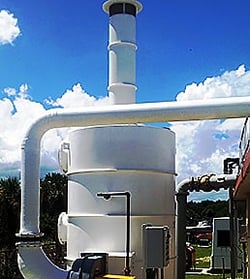
Ensuring Optimal Performance and Efficiency
When designing and installing a water treatment system, it is crucial to consider the hydraulic conditions that may arise when incorporating a degasification or aeration tower into the process. Hydraulic conditions can vary from one job to another, and the conditions created by a degasification tower are no exception. To optimize the performance and efficiency of the system, it is necessary to address potential issues such as vortex formation, increased suction on the effluent line, and water flow restrictions. In this blog post, we will explore the importance of incorporating vortex breakers, air relief valves, and anti-siphon valves to prevent hydraulic air locks and ensure the smooth operation of the degasification tower.
Preventing Hydraulic Air Locks in Degasification Towers
When a degasification tower is installed in a water treatment system, it is susceptible to hydraulic conditions that can lead to airlocks. These conditions primarily arise when the effluent drain line drops straight down for a significant distance. The resulting vortex effect causes the water to swirl, drawing air down the center and restricting the drainage of the tower. Additionally, the increased hydraulic flow and distance can create heightened suction on the effluent line, potentially causing flooding inside the degasification tower.
To avoid these issues, it is crucial to install vortex breakers inside degasification towers. Vortex breakers are specifically designed to disrupt the vortex formation, allowing for smooth water flow and preventing air locks. By strategically locating air relief valves and anti-siphon valves along the finish effluent pipeline of treated water, the risk of hydraulic air locks can be further minimized. These valves serve to release trapped air and prevent siphoning, ensuring optimal performance and preventing potential damage to the system.
Addressing Other Considerations: Decarbonation, Degasification, and Odor Control Scrubbers
Apart from preventing hydraulic airlocks, there are additional considerations in water treatment systems that warrant attention. Decarbonation is a process that removes carbon dioxide from water, particularly important in applications where low alkalinity and pH control are essential. Degasification, on the other hand, involves removing dissolved gases from water, often through the introduction of air or other methods like vacuum stripping or membrane degasification.
In certain cases, water treatment systems may also require odor-control scrubbers. These scrubbers effectively remove unpleasant odors caused by chemical reactions or the presence of certain compounds. By employing various techniques such as chemical adsorption or biological treatments, odor control scrubbers ensure the final treated water meets the desired olfactory standards.
When designing and installing a water treatment system, careful consideration must be given to the hydraulic conditions that may arise within a degasification or aeration tower. Incorporating vortex breakers, air relief valves, and anti-siphon valves into the system is crucial to prevent hydraulic air locks and ensure smooth operation. Furthermore, controlling alkalinity and pH, addressing water turbidity, and implementing decarbonation, degasification, and odor control measures are vital to optimizing the performance and efficiency of the water treatment system. By consulting professionals in the field, such as DeLoach Industries Inc., you can gain valuable insights and expertise to tailor your water treatment system to your specific needs and requirements.
Receive Your Free Odor Control E-Book
Related Blog: Degasification Tower Design: Square vs. Round?





